67 F. average high on May 11.
56 F. high on May 11, 2016.
May 12, 1922: A strong cold front moves through western Minnesota, replacing shorts with sweaters at Morris. The temperature dropped from 91 to 26 on this date.
Fishing for a Weekend of Perfect Weather?
At least we don't have to worry about blowing dust. On this date in 1934 the sky over Minnesota was black with clouds of roiling dust; half-foot drifts of topsoil - dirt getting inside homes. There was no place to hide from the dust storm, the result of original prairie grass being being plowed under to plant wheat. New, gas-powered tractors accelerated the plowing; a series of storms lifting topsoil into the air as far east as Boston and Atlanta. Soil management has improved dramatically since the 30s. We all want to believe there couldn't be another Dust Bowl.
Conditions look good for Saturday's Minnesota Fishing Opener. In fact, weather may be "too nice" (too sunny, winds too light?) I'm no fishing expert - if I can't catch walleye up on Pelican I'll blame the weather.
We may see highs near 80F Saturday and Sunday in the Twin Cities; upper 70s up north with comfortable humidity levels. The dreaded dew point reaches the 60s next week, fueling outbreaks of strong to severe thunderstorms. Statistically we're due for some hail and high water.
But Saturday should be ideal.
On This Date in 1934: Massive Dust Storms Sweeps from Midwest Into Eastern USA. History.com has a good overview: "On this day in 1934, a massive storm sends millions of tons of topsoil flying from across the parched Great Plains region of the United States as far east as New York, Boston and Atlanta. At the time the Great Plains were settled in the mid-1800s, the land was covered by prairie grass, which held moisture in the earth and kept most of the soil from blowing away even during dry spells. By the early 20th century, however, farmers had plowed under much of the grass to create fields. The U.S. entry into World War I in 1917 caused a great need for wheat, and farms began to push their fields to the limit, plowing under more and more grassland with the newly invented tractor. The plowing continued after the war, when the introduction of even more powerful gasoline tractors sped up the process. During the 1920s, wheat production increased by 300 percent, causing a glut in the market by 1931..." (Image: History.com).

Super-Soggy Pattern Continues. The pattern continues to favor significant rainfall amounts. Today's storm pushes showers and heavy T-storms across the Lower Mississippi Valley and the Southeast into the Mid Atlantic Region; heavy rain reaching New England by Saturday as the system intensifies into a strong coastal storm. The central USA enjoys warm, dry weather, but yet another sloppy storm pushes into the Pacific Northwest with snow for the highest elevations. NAM guidance: NOAA and Tropicaltidbits.com.
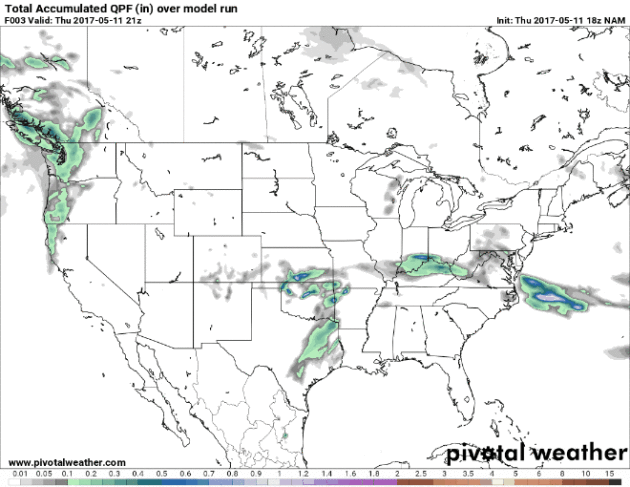
An Overview of the Modern Tornado Record, 1950 Through Present. U.S. Tornadoes has an excellent overview of tornado technology, frequency and trends over time: "...In the 1950s there was a practical use of numerical weather prediction and development of computers. Forecasts were done by hand, on printed weather maps. By the 1960s, numerical weather prediction by computer began. The first successful weather satellite was launched, TIROS-7. On a 78-day mission, it relayed thousands of images showing large-scale cloud regimes, thus proving that satellites can provide useful information and surveillance of global weather from space. This satellite paved the way for the Nimbus Program, a NASA and NOAA collaboration for decades that advanced further research and use of satellite programs. During the first 20 years of the database, tornado reports steadily grew as awareness grew. The Palm Sunday outbreak in 1965 has been attributed to some of the growth in awareness. Forty-seven tornadoes occurred on April 11th and 12th in Indiana, Michigan, Ohio, Wisconsin, Iowa and Illinois. They killed 271. In many ways, it was a generational tornado outbreak like 2011 despite its lower death toll. History is replete with big tornado events that bring discussion of their destructive force out of hiding..."
Graphic credit: Tornadoes by year. (Ian Livingston/ustornadoes.com).
Thousand-Year Flood for Missouri? Here's an excerpt of an analysis at Climate Signals: "A major slow-moving storm brought heavy rains, dangerous winds, tornadoes, and flooding across much of the central US beginning April 28. States from Oklahoma to Indiana recorded extreme three-day rainfall totals of 5 to 11 inches.[1] Eastern Texas saw two EF-3 tornadoes and Kansas experienced a rare late-season blizzard. An impressively large area of 100- to 1,000-year rains hammered Missouri[2][4] and the Ozarks were hit by record-shattering flood crests. At least 20 people have been killed.[3] Climate change is amplifying rainfall across all storm types. One of the clearest changes in the weather across the globe and in the US is the increasing frequency and intensity of heavy rain and snow. A warmer atmosphere holds more water, and storms supplied by climate change with increasing moisture are widely observed to produce heavier rain and snow..."
How to Survive a Flash Flood. There's some very good information (you pray you'll never need) at lifehacker: "...If the water comes at your vehicle suddenly and you have no time to get away, you need to get out as quickly as possible. If you’re stuck and the water is rising, unbuckle your seatbelt, roll down your windows, break them with a specialized tool, or kick them out to allow water to flow freely into the vehicle. If you don’t, you won’t be able to open your doors because nearly 2,000 pounds of pressure will be pushing against it. Once water comes in and the pressure equalizes on both sides—which will take less than a minute—you’ll be able to open the car doors or swim out of the window opening. Abandon your car and move to higher ground following the on-foot rules explained above..."
Illustration credit: Angelica Alzona.
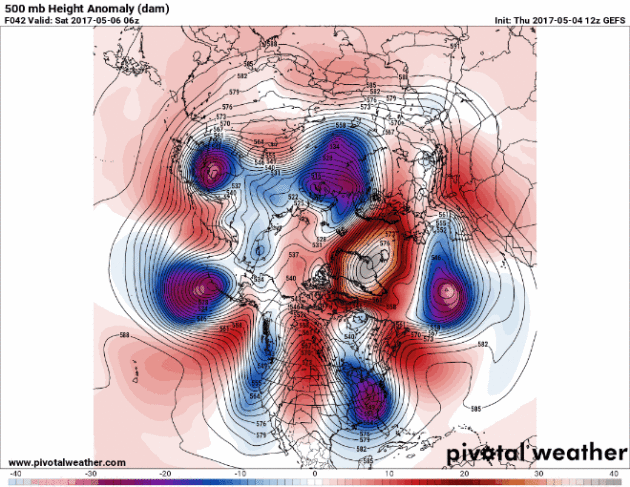
Animation credit: Pivotal Weather. "Ensemble forecast 500mb heights and anomalies through May 14."
Image credit: Earth Institute, Columbia University.
As Heat Index Climbs, Emergency Visits, Deaths Rise in New England. It turns out the Heat Index (temperature + dew point) doesn't have to be as high as thought for people to succumb to the heat. Here's an excerpt from Brown University: "New research shows that New Englanders are susceptible to serious health effects even when the heat index is below 100, a finding that has helped to change the National Weather Service threshold for heat warnings...Data from the study, published in Environmental Research, has helped to shape a new National Weather Service policy for the New England region, according to a recently posted statement from the service’s eastern region headquarters. “The old threshold of 100 to 104 degrees Farenheit for two or more consecutive hours has been lowered to 95 to 99 degrees Farenheit occurring for two or more consecutive days, or any duration of heat index 100 to 104 degrees Farenheit,” the statement says..."
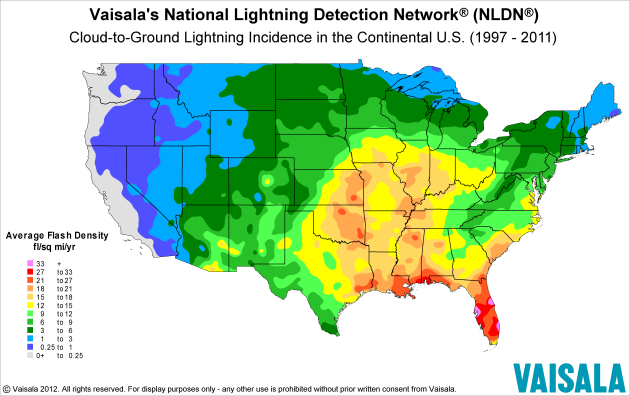
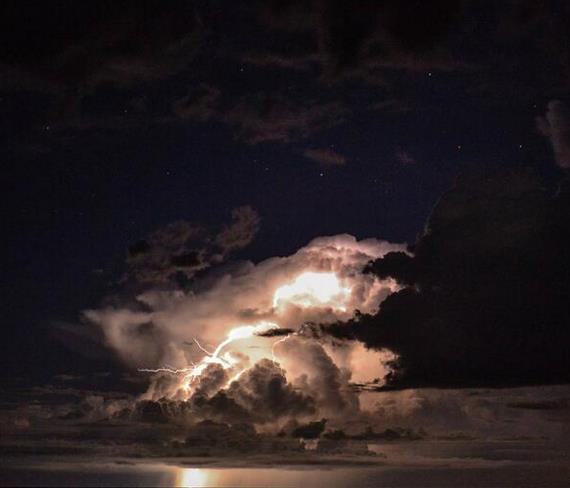
File photo: A.J. Pena.
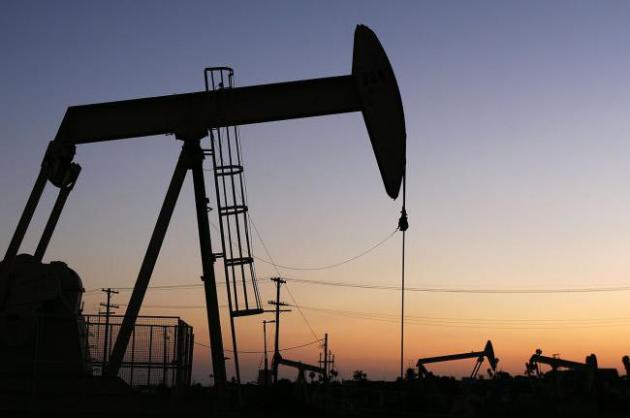
Tesla's Solar Roof Pricing is Cheap Enough to Catch Fire. Bloomberg has a good overview of the technology: "...The vision Musk describes with the solar roof is the grand unification of Tesla’s clean-energy ambitions, combining solar power, batteries, and electric cars. “These are really the three legs of the stool for a sustainable energy future,” Musk said. “Solar power going to a stationary battery pack so you have power at night, and then charging an electric vehicle … you can scale that to all the world’s demand.” The rooftop shingles are virtually indistinguishable from traditional high-end roofing products, with discreet solar cells embedded beneath a glass surface. From most viewing angles, they look just like ordinary shingles, but they allow light to pass through from above onto a standard flat solar cell..." (photo credit: Tesla).
Image credit: "Rendering of Yara's self-driving ship." (Yara)
Over 450 million LEDs have been installed to date in the United States, up from less than half a million in 2009, and nearly 70% of Americans have purchased at least one LED bulb. Compact fluorescent lightbulbs (CFLs) are even more common, with 70%+ of households owning some CFLs. All told, energy-efficient lighting now accounts for 80% of all U.S. lighting sales.LEDs use 85 percent less electricity than incandescent bulbs..."
Why Electric Car Early Adopters Went Electric + Best Things About Driving Electric.
For me it was the ability to save money (charging at home late at
night), lower insurance and MUCH less maintenance. There are 150 moving
parts on my Tesla, compared with roughly 10,000 moving parts on a
traditional gas-powered vehicle. There is simply less that can go wrong.
Here's an excerpt from Clean Technica: "...Environmental
benefit” was still the leading response, but the gap narrowed hugely
for this question versus the previous one. Drive quality was illuminated
as a dramatic benefit of EVs in this section. “The smooth and quiet
drive” of EVs and “the fun and/or convenience of instant torque” were in
close contention for the #2 spot. However, they both concern drive
quality and could have been combined if we chose to go that route. In
such a case, “drive quality” may well have risen to #1. The remaining
benefits rather evenly split the pie, with some notable differences by
region and type of EV, as highlighted in the previous section. However,
one more benefit worth pulling out here is “low maintenance.” It didn’t
perform well at all in the previous section, but it gets quite a bit of
love here — comparable with several other topics, on average..."
46% of "TV Screen Time" Spent Watching Traditional Linear TV? Netflix, Amazon and Hulu are catching on - getting to be a regular habit according to new research highlighted at iab.com: "...56% of U.S. Adults own a Streaming Enabled TV which is a 56% rise from 2015. The majority of time Americans are watching TV (54%) is spent streaming video (20%), which can include network TV shows, subscription service original shows, or original digital video content.
Some additional key highlights from the study include:
- 46% of American’s ‘TV Screen Time’ is spent watching Traditional Linear Programming
- Half of Streaming Enabled TV owners (50%) say they prefer watching commercials over paying for ad-free subscriptions when streaming video on TV..."
Photo credit: "We’re in a TV renaissance, but keeping up is a commitment. The Hulu with Live TV app recognizes we don’t need more choices, just better choices." Photo: Emily Prapuolenis/The Wall Street Journal.
Minneapolis Named Best Place for Doctors to Avoid Burnout. Who knew? Details via Minneapolis - St. Paul Business Journal: "The
weather in Minneapolis is often cold, but when it comes to avoiding
doctor burnout, it's No. 1. According to Medscape, a medical trade
publication, Minneapolis ranks as the best place for physician
satisfaction when it comes to a calm life coupled with professional and
personal satisfaction. Factors used in the study include: the number of
medical malpractice lawsuits, least punitive medical boards, teamwork
with physician assistants and nurse practitioners, local amenities and
overall quality of life..."
File image: US Chamber of Commerce Foundation.
“Murmuring is wasted breath, and fretting is wasted time.” – Charles H. Spurgeon
TODAY: Partly sunny skies. Winds: SW 5-10. High: 72
FRIDAY NIGHT: Partly cloudy. Low: 53
SATURDAY: Plenty of sun, risk of a few walleye. Winds: S 5-10. High: 78
SUNDAY: Partly sunny and warm, touch of June. Winds: SE 10-15. Wake-up: 57. High: 81
MONDAY: Fading sun, few T-storms. Winds: SE 10-15. Wake-up: 62. High: 80
TUESDAY: Very humid, strong T-storms around. Winds: S 15-25. Wake-up: 63. High: 84
WEDNESDAY: Still muggy, more showers and T-storms. Winds: W 10-20. Wake-up: 62. High: 74
THURSDAY: More sun, less humidity. Winds: NE 7-12. Wake-up: 55. High: 69
Climate Stories...
A Place for Faith and Science When It Comes to a Changing Climate. On Wednesday Dr. Mark Seeley and I lead a panel on faith-based climate messaging at the National Adaptation Forum in St. Paul. Scientists and thought-leaders representing Christianity, Judaism and Islam agreed that appealing to hearts and minds is critical. A joint statement issued on the role of faith and climate change messaging is below. And don't bury the lead: viable solutions exist today. You can club people over the head with the stick of climate gloom and doom, or hold up a carrot of hope: we can have everything we want and need, save money and retool our economy, while emitting less warming carbon pollution. There will be disruption and dislocation, but I'm optimistic we'll figure it out. Because in the end we won't have a choice.
2017 National (Climate) Adaptation Panelists focused on faith-based messaging, from left to right: Mark Seeley, Dr. Teddi Potter, Paul Douglas; Mitchell Hescox; Odeh A. Muhawesh; Rabbi Fred Scherlinder.
Climate Change is Turning the American Southwest into "Mad Max". Esquire digs into the data and the trends: "...According to the study, the number of dust storms that the American southwest experiences each year has more than doubled from the 1990s to the 2000s. These storms—which can spread infectious disease, damage airplane engines, disrupt land transportation, wreak further havoc on drought-ravaged farms, and serve as a key component of the Mad Max lifestyle—are likely more frequent because of warmer ocean temperatures in the Pacific Ocean. That, according to the EPA (last year), is one of many splendid results of climate change. Dust storms now strike the Southwest 48 times a year, compared to an average of 20 times per year during the 1990s. Researchers traced the spike to a combination of warmer sea temperatures in the North Pacific and colder waters off the California coast, which allows the cooler, drier winds from the North Pacific to come sweeping into the southwestern United States. That has dried out the soil, and kicked up more dust storms..."
Photo credit: Joseph Plotz/NWS/NOAA). "A July 2012 dust storm in Gilbert, Arizona."
Map credit: "The perimeter of Sperry Glacier in Glacier national park in 1966,1998, 2005, and 2015." Photograph: US Geological Survey.
Photo credit: "Glacier National Park is losing its glaciers as global temperatures rise. When the park was founded in 1910, it had about 150 glaciers. Today, only 26 still meet the 25-acre threshold to be called a glacier." Credit: Jinrui Qu/CC-BY-SA-2.0.

Arctic Heating Up Twice as Fast as Rest of the Globe. CNN reports: "The Arctic is heating up twice as fast as the rest of the world -- triggering a "massive decline in sea ice and snow," according to a new federal report. On Tuesday, the National Oceanic and Atmospheric Administration released its 11th annual Arctic Report Card, which compiles data from 61 scientists in 11 countries. "Rarely have we seen the Arctic show a clearer, stronger or more pronounced signal of persistent warming and its cascading effects on the environment than this year," Jeremy Mathis, director of NOAA's Arctic Research Program, said in a statement..."
Animation credit: Arctic ice melt from 1984 to 2016. Courtesy of NASA.
New Book Ranks the Top 100 Solutions to Climate Change. The Results Are Surprising. You'll never guess what's number 1. Here's an excerpt of an interview with Dave Roberts at Vox: "...We
thought at least the top of the list would — solar, wind, wind, solar.
Because that’s what you hear from Charles Ferguson, Al Gore, [Jeffrey]
Sachs, or Christiana Figueres. They’re all saying the same thing. It’s
understandable — 62 percent of the [greenhouse gas] molecules up there
came from fossil fuel combustion, so you just invert it, right? It makes
sense. It just doesn’t work out that way. If you take solar, which is
eight and 10 [on the list], and wind, which is two and 22, and you
combine them, they are definitely near the top. But you can’t model on-
and off-shore wind the same, because the economics are vastly different.
And you can’t model rooftop and solar farms in the same model. So in
some cases we broke things up that people think of as aggregated. But
even then, the number one solution is educating girls and family
planning..."
Historic Flooding in Quebec Probably Linked to Climate Change: Experts. Here's an excerpt from The Montreal Gazette: "Some
may blame the gods, Hydro-Québec or their own bad luck, but climate
change scientists say the heavy rains and terrible flooding plaguing
Quebec this spring are almost certainly caused by global warming.
“There is a very clear picture emerging that we’ve changed the
chemistry of the atmosphere with our greenhouse gases and we are really
seeing the consequences now,” Paul Beckwith, a climate systems scientist
who teaches at the University of Ottawa and Carleton University, told
the Montreal Gazette in an interview Tuesday. Record amounts of rain
this spring in Quebec and Ontario have meant the soil is saturated and
can’t absorb any more water. The run-off adds to the water levels
in already bloated rivers and streams. Lake Ontario has now hit its
highest recorded level since 1880, when record-keeping began. The St.
Lawrence River is about 1.2 meters higher than it normally is this time
of year..."

Global temperatures could exceed 1.5 degrees Celsius above their preindustrial levels within the next 15 years, according to a new scientific study, crossing the first threshold under the Paris climate agreement and placing the world at a potentially dangerous level of climate change. The report comes as climate agreement participants are watching the United States — where the Trump administration is debating whether to withdraw from the Paris accord — and as scientists with the Intergovernmental Panel on Climate Change are working on a special report about the 1.5-degree goal (equivalent to 2.7 degrees Fahrenheit) and the consequences of overshooting it..." (File image: NASA).
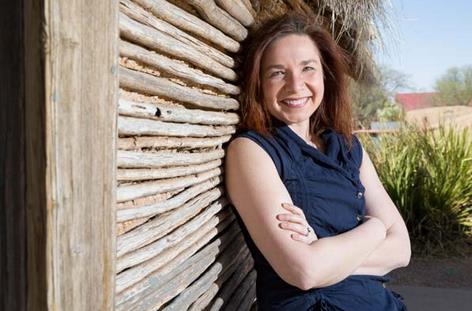
Photo credit: "The ice cliffs of West Antarctica." Michael Martin/laif/Redux.
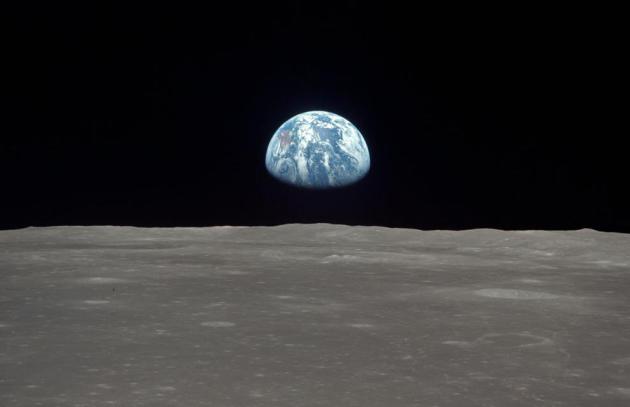
No comments:
Post a Comment